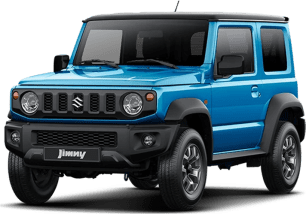The Jimny might be a little bit more work than you’re used to if you’re swapping out of a hatchback or small city SUV.
That’s not meant to sound like a scathing criticism, either, because despite its cutesy appearances and (whether intended or not) appeal to young inner-city types, the Jimny is a ladder-frame chassis off-roader. And it drives like one.
During my time with the Jimny XL, each Instagram story I posted would garner at least a couple of responses in the vein of ‘What’s it like?’ or ‘Should I buy one?’ from people in their late 20s and 30s who I’m 70 per cent sure wouldn’t care much for off-roading.
Most of my responses were probably disappointing to them, because it drives like a small 4X4 and if you’re going to get annoyed by steering corrections, vibrations and noise, it might not be for you.
But if the little Zuki’s off-road ability (or even just its irresistibly endearing looks) are appealing enough to you, the Suzuki is a fairly easy steer once it becomes second nature. In fact, its engaging nature is part of what makes the Jimny fun to drive.
Reacting to strong winds or changing road surfaces should be familiar to those who grew up driving older, more rudimentary cars, and even though there’s a fairly noticeable ‘dead’ spot in the centre of the Jimny’s steering, it means you’re able to more subtly adjust (quite regularly, you may find) the steering wheel to keep aligned in your lane.
The suspension can feel a little soft and ‘jostly’ - lean to the side while you’re stopped at an intersection and you’ll feel the Jimny lean too - it’s also a decent reason to be a little cautious with your speed around corners. The Jimny will let you know if you’re going too quickly.
Sure, the longer wheelbase of the XL should help with stability over the three-door, but the nature of the Jimny doesn’t exactly encourage you to find out how much more stable exactly. But it’s fortunately not so much bigger that it sacrifices its advantage over most other off-roaders.
Its ability to get around inner-city areas in the Jimny is a plus if you live urban but need something that can head off-road on weekends - the XL is still relatively small compared to anything else that’s intended for the trails. It feels perfectly comfortable in Melbourne’s laneways and underground car parks in the CBD… as long as you’re okay with how heavy the steering can feel at low speeds.
For trips out of the city where you’ll be getting the Jimny’s tyres a bit dirty (hopefully, it’s what it was built for), just know that the Jimny doesn’t feel its best at highway speed. Its 75kW is pushed to its limit, 130Nm doesn’t inspire great overtaking confidence, its steering and suspension don’t feel massively dialled-in, and the four-speed automatic transmission has a whine to it that’ll bring back memories of watching the V8 Supercars cut laps in 2002.
But like I said, if you’re not looking for a car that’ll use sensors to sit you in the dead-centre of your lane while a leather seat massages your back, the Jimny’s simple nature is endearing, and most of the time quite fun.
As a side note, CarsGuide’s off-road expert Marcus Craft has published an in-depth off-road test of the Jimny XL, and gave it a thumbs up as a capable vehicle for tricky trails - it’s worth reading or watching if you’re considering the Jimny as an adventure companion.





















































 copy.png)




.png)








